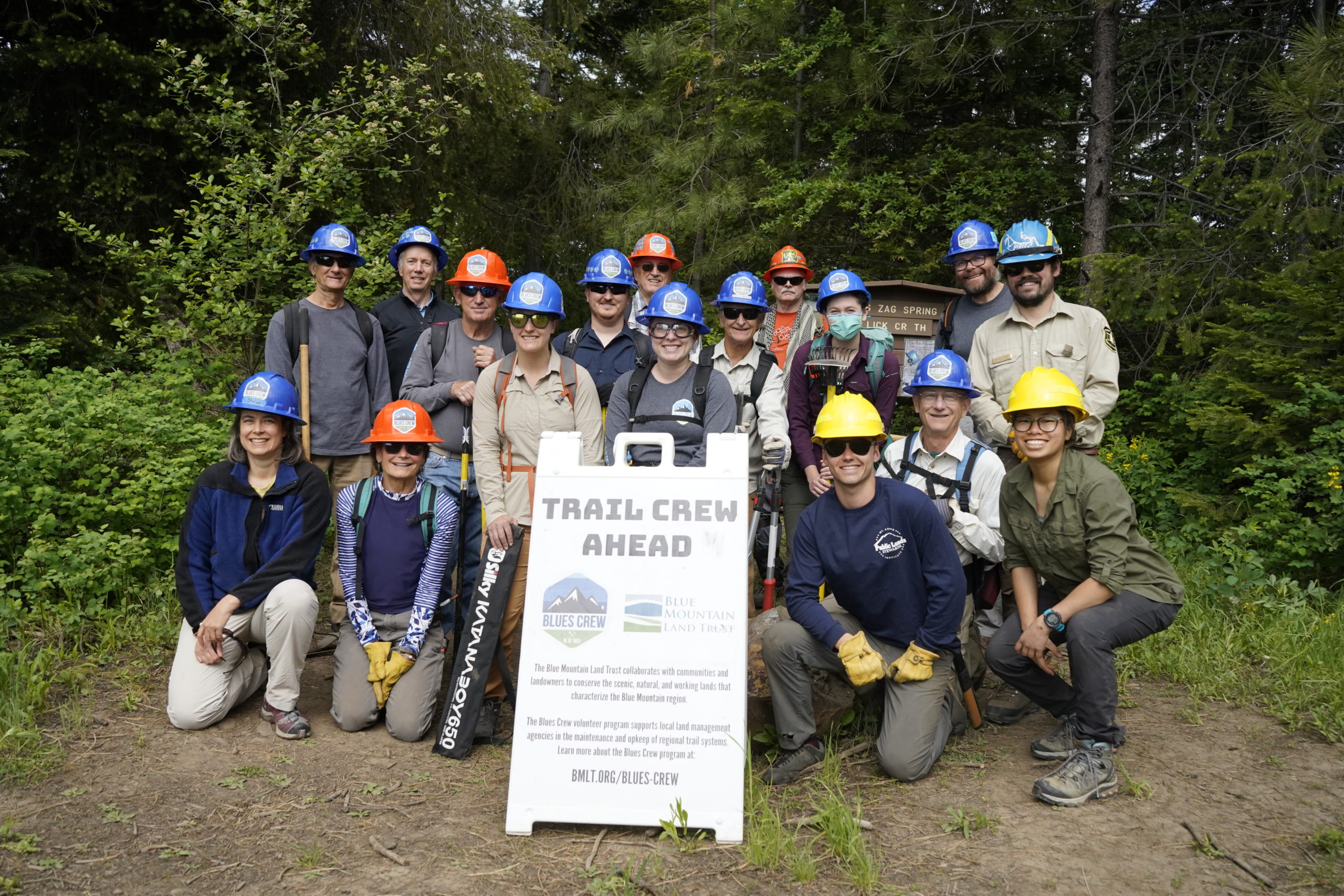Growing up, the seven Leave No Trace principles, accompanied with mnemonic gestures, were instilled in me as a set of reminders to guide my behavior both in and out-of-doors.
As I got older, I learned the ecological and ethical basis for upholding Leave No Trace (LNT) practices. Now, as a trail and recreation steward with the Umatilla National Forest through the Mt. Adams Institute’s Public Lands Stewards AmeriCorps Program, I am gaining a new perspective and understanding not only of the LNT principles themselves but also of what it takes to make practicing LNT possible.
On my first day at my service site with the Walla Walla Ranger District, I jumped right into trail work. I was cutting back brush, rolling logs, hacking away at small trees and roots, swinging pulaskis at root wads, and pulling cross-cut saws taller than myself through fallen trees. Trail maintenance is not dainty work. At their worst, some trails look like a friendly, or perhaps not-so-friendly, large-footed, forest-dwelling cryptid had passed through both before and after we cleared it. Except, in the latter circumstance, a trail had been incidentally blasted through the side of the mountain. While it is exciting to emulate our heavy-footed friend, heaving several hundred-pound trees, logs, and limbs off of the trail and watching them tumble down the mountain, I was shocked at how destructive, impactful, and yet necessary our work is.
Of the seven LNT principles, I want to focus on the second principle: travel and camp on durable surfaces. So what does that mean? Travel in the outdoors inevitably impacts natural areas. Land management agencies, such as the U.S. Forest Service, are concerned with how our presence impacts the “durability” of the “surface” (land) and also whether and how the land can permit safe travel for visitors. The trail crew works to maintain designated trails to concentrate the impact of foot and stock traffic. We ask ourselves, is the trail safe enough for recreational use? Can we recreate without creating any further and/or unnecessary damage to this trail?
Safety is our primary charge; ourselves, the public, and the land itself. That may mean proactively taking down more trees than the primary problem tree. Small trees and limbs pinned under larger trees, aptly named spring poles, can have explosive tension. They can shatter or snap back if cut haphazardly or sling back uncontrollably if not addressed before removing the impinging tree. Safety may also mean closing a trail entirely if it is too damaged. Our work must also comply with the rules and regulations of the land. In “designated wilderness,” the use of motorized equipment is prohibited. There is no delicate way to lift and place a 300-pound log off the trail. Dragging, rolling, heaving, shoving, or cutting; we will do what it takes to safely remove obstacles from trails. In areas where the use of motorized equipment is permitted, we ride motorized dirt bikes and use chainsaws. Dirt bikes and chainsaws are unquestionably more impactful than hiking and manual cross-cut saws. Yet, at the same time, without the help of motorized equipment, there is no way we could keep up with visitors and the endless amounts of trail work. As I later describe, allowing visitors to venture ahead into unmaintained areas makes the land more vulnerable to unsustainable impacts. So why do we do the work we do the way we do it? It seems like one big step back! In some sense, it is. But it allows us to take two steps forward.
The first step forward is that by clearing designated trails, trail crews make outdoor recreation in an
LNT-friendly manner, possible. During the pandemic, there was a 300% increase in visitors to the Umatilla National Forest alone. Not going outside is not a solution. More and more people are getting outside, and the way to allow more people to do so in an LNT-friendly manner is to have designated trail systems. Without trails, visitors will go any which way, blazing undesignated trails, eroding the soil, and disturbing the natural vegetation. There are inevitable impacts of being outdoors, and it is better to have one designated trail than many poorly chosen paths.
The second step is up to you, to me, to all of us. It is the ongoing choice to follow established trails and observe usage regulations. Taking this step sustains a precedent for all visitors. Just as the choice to abide by LNT is ongoing, so too is the work of clearing trails. The outdoors is subject to the laws of nature, and many times our work is undone faster than we can do it. Another crucial way this second step forward is taken is through partnerships. Volunteer trail crews, such as the Blues Crew, help us tremendously with the labor needed to maintain trails.
In just a few short months of this internship, my understanding of the Leave No Trace principles has expanded more than I thought it would and more than it ever could have in a classroom. As a recent college graduate during the COVID-19 pandemic, the opportunity to be immersed in the concepts and theories I had only talked about in a classroom has been a drastic and welcome change. Surprisingly, there is something about the timbre of a chainsaw and the whir of a dirt bike that invokes contemplative thought. I have gained new perspectives on the importance of Leave No Trace and what it takes to make LNT in outdoor recreation possible. Taking one step back to take two steps forward is not a bad thing, and we ought not to be discouraged by it.

